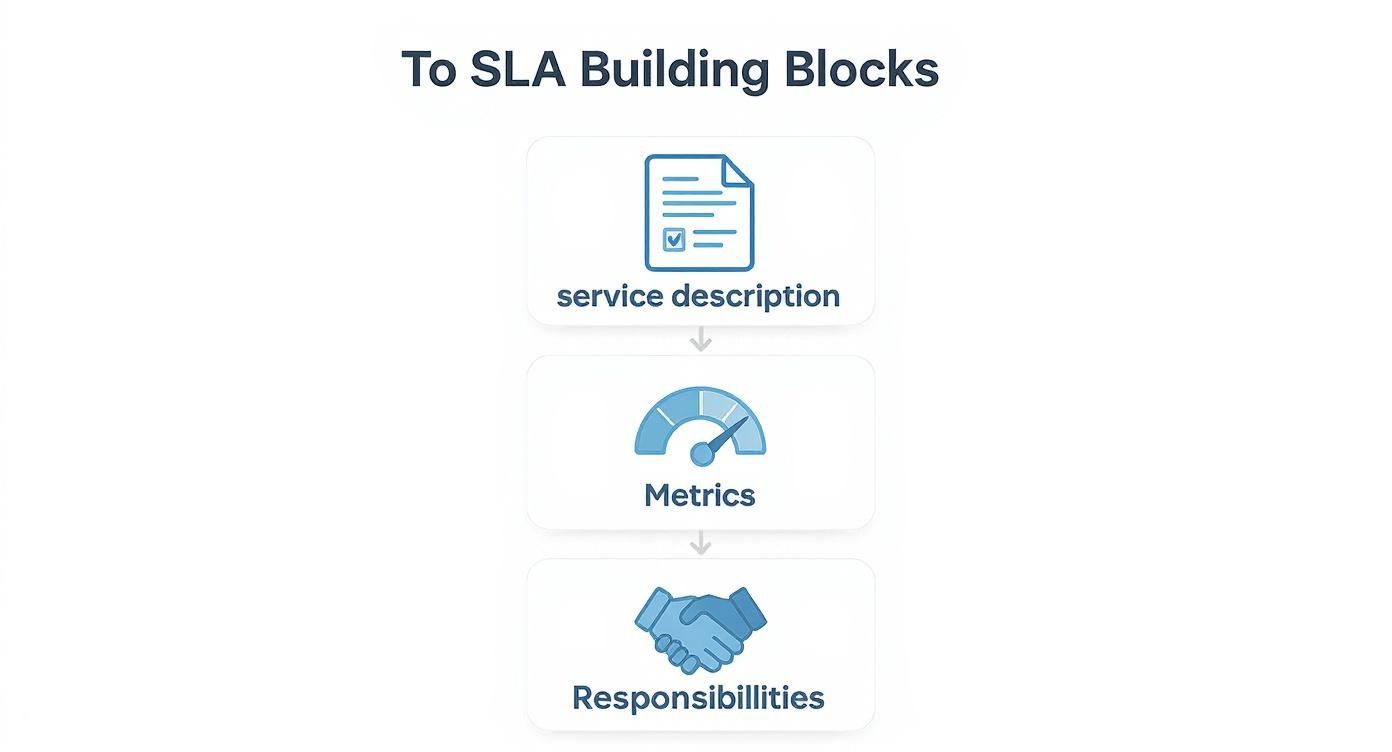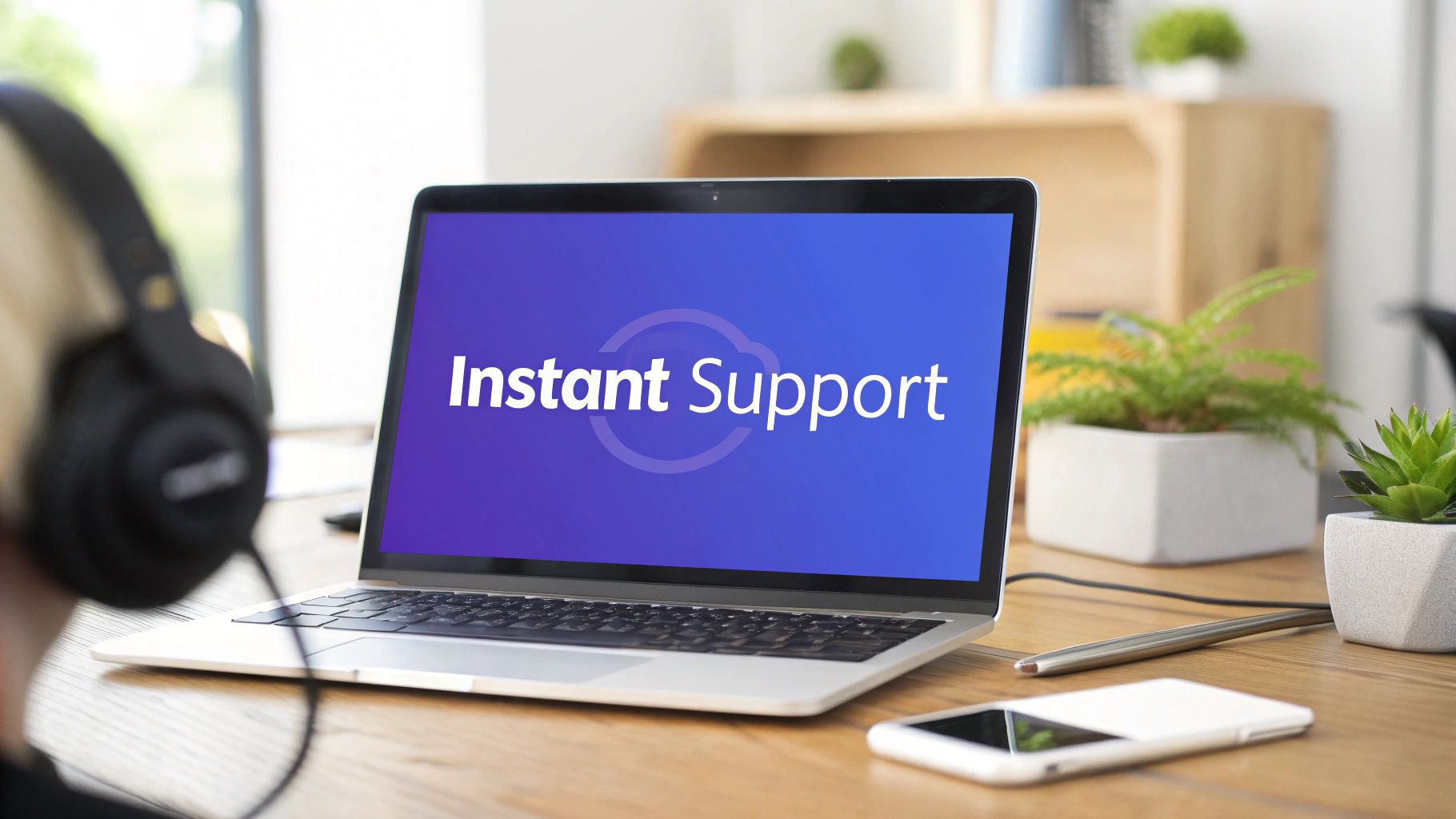What Are Service Level Agreements Explained Simply
Wondering what are service level agreements (SLAs)? This guide explains SLAs in plain terms, showing you their key parts and why they are vital for business.

A Service Level Agreement (SLA) is the official rulebook for a business relationship. It’s a formal contract between a service provider and a client that gets everyone on the same page about what is expected. No guesswork, no assumptions—just clear, documented standards.
The Official Rulebook for Your Business Relationship

Imagine hiring a lawn care service. You wouldn't just pay them to "take care of the yard." You'd want specifics: mow every Tuesday, trim the hedges monthly, and what happens if they miss a week? An SLA brings that same level of detail to professional services, turning vague promises into commitments you can actually measure.
This document is the foundation of a trusting partnership. It makes sure both sides agree on what "good service" truly looks like, creating a shared vision from day one.
Setting Clear Expectations
At its core, a service level agreement is all about managing expectations. It cuts through the fog by spelling out every important piece of the service arrangement, including things like:
- Scope of Services: A precise breakdown of what the provider will deliver.
- Performance Metrics: The specific, measurable standards used to judge quality (e.g., 99.9% system uptime).
- Responsibilities: A clear outline of who does what—for both the provider and the client.
- Penalties and Remedies: The agreed-upon consequences for not meeting the service levels.
This is about building a partnership on solid ground and avoiding arguments later. When a problem pops up, the SLA is the single source of truth everyone can turn to. To see how these agreements fit into the bigger picture, it’s helpful to know the differences between OLA and SLA.
For a quick reference, here's what an SLA boils down to.
SLA Core Concepts at a Glance
An SLA keeps both parties honest and focused on what matters most.
An SLA transforms the client-provider relationship from a subjective partnership into an objective one. It's not about hoping for good service; it's about defining it with data and agreeing on how to measure it.
The Building Blocks of a Strong SLA
A dependable service level agreement is built on a few core components that leave no room for guesswork. Think of these as the key ingredients in a recipe; leave one out, and you risk spoiling the entire dish. These building blocks clearly define the who, what, when, and how of the service relationship, making sure both sides are perfectly aligned from day one.
It all starts with a clear description of the services being provided. This is an exhaustive list of every single task and deliverable the client can expect. Just as importantly, it identifies all the parties involved and maps out who is responsible for what.
Defining Success with Performance Metrics
Once everyone knows what’s on the table, the next question is: how do we measure success? This is where performance metrics come in. They are the specific, quantifiable numbers that show whether the service provider is actually meeting its promises, turning vague goals like "good support" into concrete, measurable targets.
Common performance metrics usually include things like:
- System Uptime: Often shown as a percentage, like 99.9% availability, this metric simply tracks how much time a system is operational and accessible to users.
- Response Time: This measures how quickly the provider acknowledges a customer request or issue. A common example is a "two-hour initial response time" for support tickets.
- Resolution Time: Going a step further, this metric tracks the total time it takes to completely solve a customer's problem, from the moment it was first reported.
Standardizing these metrics has become a key practice for fair agreements. For example, most SaaS vendors now guarantee at least 99.5% uptime, while premium providers often promise 99.9% or higher. Knowing the benchmarks for terms like these helps businesses negotiate smarter contracts. You can learn more about how SLA metrics are benchmarked on blog.termscout.com.
Clarifying Roles and Responsibilities
A strong partnership is a two-way street, and a good SLA reflects that. This component clearly outlines the responsibilities of both the service provider and the client.
For the provider, this could mean maintaining software, providing regular performance reports, or offering 24/7 support. For instance, many companies are exploring the benefits of self-service portals to let customers help themselves, which can be defined as a provider's responsibility.
Client responsibilities are just as important for success. These might include providing timely access to necessary systems, giving clear and actionable feedback, or making sure their internal team is available for collaboration.
A great SLA doesn't just list what a provider will do. It also specifies what the client needs to do for the provider to be successful, creating a true sense of shared ownership.
Planning for When Things Go Wrong
Let's be realistic: even with the best intentions, services can sometimes fall short. A solid SLA anticipates this by detailing the remedies or penalties for failing to meet an agreed-upon standard. This isn't about punishment; it's about accountability and making sure the client is compensated for any service disruption.
These terms might include:
- Service Credits: A common remedy where the client receives a discount on their next bill as compensation.
- Financial Penalties: For more significant service failures, this could involve direct payments.
- Termination Clause: A condition that allows the client to end the contract if performance is consistently poor, offering a clear exit strategy.
This section also typically includes a clear process for resolving disagreements. Having a structured path to follow if disputes arise can save both parties a lot of time and frustration down the road.
Exploring Different Types of SLAs
Service Level Agreements aren't a one-size-fits-all deal. They’re designed to be flexible, adapting to different business relationships and specific needs. Instead of a single rigid format, SLAs are usually structured in one of a few key ways to best fit the situation.
Figuring out these different models helps you pick the right approach for your own services and clients, which makes the whole agreement more effective and relevant from the start.
SLAs are typically categorized based on what they cover: a specific customer, a particular service, or a mix of both. Each type has a distinct purpose, whether it's creating custom terms for a VIP client or standardizing a service promise for every user of a single product. Let's break down the three most common structures.
Customer-Based SLAs
A customer-based SLA is exactly what it sounds like: a single agreement that covers all the services one specific customer (or customer group) gets from you. This approach is perfect for businesses with major clients who have unique requirements that just don't apply to everyone else.
Imagine a large corporation that uses a managed IT provider for everything from cloud storage to help desk support. Instead of juggling separate agreements for each service, one customer-based SLA defines the performance standards for all services provided to that company. This keeps things simple and consolidated for a key partner. How you structure your support team, like the differences between a help desk vs service desk, can also shape how you deliver on these agreements.
This infographic breaks down the foundational components of any strong SLA.

As you can see, a clear service description, measurable metrics, and defined responsibilities are the non-negotiable building blocks for any effective agreement.
Service-Based SLAs
On the other hand, a service-based SLA applies one standard set of terms to all customers using a specific service. This is the most common type you'll see with companies offering a single product to a wide audience, like a software-as-a-service (SaaS) platform. Every customer, big or small, agrees to the exact same conditions.
For example, a project management tool might offer a service-based SLA that promises 99.9% uptime and a four-hour response time for support tickets to every single paying user. This model is incredibly efficient because it standardizes the service promise, making it easy to manage and communicate expectations across your entire user base. No special treatment, just one clear standard for all.
Multi-Level SLAs
Finally, there's the multi-level SLA, which is a hybrid approach that neatly combines different layers into a single, comprehensive structure. The goal here is to avoid duplication and complexity, making it ideal for large organizations with many internal departments or a variety of external clients.
A multi-level agreement typically has three layers:
- Corporate Level: This is the big-picture stuff. It covers general issues relevant to the entire organization, like security protocols and availability promises. These terms apply to everyone, no exceptions.
- Customer Level: This layer gets more specific, addressing issues relevant to a particular customer group or department, but not necessarily all of them.
- Service Level: This is the most granular layer, detailing the specific terms for a single service being provided to that customer group.
This tiered structure lets you customize agreements without having to rewrite the entire thing from scratch every time you add a new service or bring on a new client. It’s all about building on a solid foundation.
Why Your Business Depends on Effective SLAs
Let's be honest, the term "service level agreement" sounds a bit dry. But don't let the formal name fool you. A well-crafted SLA is one of the smartest things you can do to bring stability and predictability to a client-provider relationship. Think of it as a shared source of truth that keeps everyone aligned and accountable.
Its most immediate benefit is building trust. When both parties agree on specific, measurable goals right from the start, it completely removes the guesswork. This shared view makes communication so much easier because every discussion is grounded in concrete data, not just subjective feelings about service quality.
Building Accountability and Protection
An SLA acts as a shield for both the client and the provider. For the client, it’s a guarantee of the service they can expect. For the provider, it clearly defines their obligations, which helps manage client expectations and prevent that dreaded "scope creep" from taking over a project.
This documented clarity really shines when things don't go as planned. The agreement spells out the remedies for service failures, like service credits or other forms of compensation. Having this framework pre-agreed means problems get resolved based on the contract, not on emotional or contentious negotiations. It’s a fair process for everyone involved.
The demand for this kind of clarity has fueled some serious growth in related technologies. The global market for SLA Tracking Systems was valued at around USD 1.2 billion and is projected to hit USD 2.8 billion by 2033.
A good SLA serves as a pre-negotiated resolution. It turns a potential crisis into a manageable, process-driven event by setting rules for what happens when service targets are missed.
Driving Higher Service Quality
Another huge upside is how SLAs directly push for better service quality. By setting clear performance benchmarks, they give provider teams tangible goals to aim for. These metrics are powerful motivators that encourage teams to maintain high standards consistently.
This setup is especially useful for keeping a lid on operational costs and boosting efficiency. For instance, knowing how to manage cloud resources by optimizing cloud instance schedules is important for hitting uptime commitments without blowing the budget. Clients, in turn, get a fair and objective way to evaluate the service they’re paying for.
- Objective Evaluation: Clients can assess performance based on agreed-upon metrics like uptime, response time, or resolution speed.
- Continuous Improvement: Providers can use SLA data to pinpoint areas where they can improve their service delivery. Automating certain processes can be a huge help here; our guide on help desk automation offers some valuable ideas on this topic.
- Predictable Service: Ultimately, the client experiences a more reliable and consistent service because the provider is focused on hitting specific, documented targets.
Common Mistakes to Avoid When Creating an SLA
Drafting a service level agreement can feel straightforward on the surface, but a few common missteps can quickly turn a helpful document into a source of conflict. Knowing what these pitfalls are ahead of time is the key to creating an SLA that actually works—one that strengthens your relationship with a client or provider instead of straining it.

Most of the biggest issues boil down to a lack of clarity or collaboration. An SLA created in a vacuum is almost guaranteed to fail. The best ones are born from open conversations where both sides get a say in what success really looks like.
Using Vague and Unmeasurable Language
One of the most frequent errors is using fuzzy language that leaves way too much room for interpretation. Terms like "prompt support" or "high availability" sound great in a proposal, but they mean different things to different people. Without hard numbers, you’re just setting the stage for future arguments.
- What Not to Do: Promise "fast response times" for all customer inquiries.
- What to Do Instead: Define "fast" with a clear metric, like "95% of high-priority tickets will receive a first response within one hour."
This small shift from subjective goals to objective data is what gives an SLA its teeth. Every single commitment should be measurable, verifiable, and clear to everyone involved.
Setting Unrealistic Expectations
Another classic mistake is setting performance goals that are impossible for the provider to meet consistently. Promising 100% uptime might seem like a great selling point, but in the real world, it’s rarely achievable. When you hold a provider to an impossible standard, you just create frustration and erode trust.
An SLA should be an honest assessment of what can realistically be delivered. It's always better to under-promise and over-deliver than to set the bar so high that failure is inevitable.
A good SLA is grounded in historical performance data and an open discussion about what’s actually possible. This makes sure the targets are both ambitious and attainable, creating a fair benchmark for success.
Failing to Review and Update Regularly
Treating an SLA as a "set it and forget it" document is a recipe for irrelevance. Businesses change. Services evolve. Customer needs shift. An agreement that was perfect a year ago might be completely out of sync with reality today.
- What Not to Do: Sign the SLA, file it away, and never look at it again.
- What to Do Instead: Schedule regular reviews—quarterly or annually—to check in on performance, discuss what's changed, and make adjustments.
This proactive approach keeps the agreement aligned with the current business relationship, not the one you had last year.
Creating the SLA in Isolation
Finally, an SLA should never be a one-sided declaration. When a provider drafts the entire document without any input from the client, it often fails to address what the client actually needs and prioritizes. This leads to a document that technically meets its targets but still leaves the customer feeling unsatisfied.
The best SLAs are collaborative. By involving both parties in the drafting process, you get a final agreement that reflects a shared view of what matters most and what "good" really looks like.
Frequently Asked Questions About SLAs
Even after you get the hang of SLAs, a few questions always seem to pop up. It's one thing to know the theory, but another to see how it all works in practice. Let's clear up some of the most common points of confusion.
We’ll tackle the big three: how an SLA relates to a contract, how you actually track its promises, and what happens when those promises are broken.
What Is the Difference Between an SLA and a Contract?
People often get tangled up trying to figure out if an SLA is just a fancy name for a contract. The easiest way to think about it is that an SLA is a specific, detailed component that lives inside a larger contract.
Think of it like this: the main contract is the whole house, covering everything from payment terms to legal responsibilities. The SLA is the detailed blueprint for the electrical system, specifying exactly how much power goes where and what happens if a circuit blows.
An SLA gives a contract its teeth when it comes to performance. The contract might say a service will be provided, but the SLA defines what "provided" actually means with measurable, objective standards.
The contract handles the broad business relationship, while the SLA zooms in on the nitty-gritty of service quality—uptime, response times, and resolution rates. It’s what turns vague promises into concrete, trackable commitments.
How Do You Measure SLA Performance?
You can't manage what you don't measure, and that’s the entire point of an SLA. Performance isn't based on feelings or vague impressions; it’s tracked using specific, predefined metrics called Key Performance Indicators (KPIs) or Service Level Indicators (SLIs).
These are hard numbers that paint a clear picture of how a provider is doing. Some of the most common metrics you'll see are:
- System Uptime/Availability: This is the percentage of time a service is online and working. A target of 99.9% uptime is pretty standard, which leaves very little room for outages.
- Support Response Time: How quickly does the provider acknowledge a problem? An SLA might guarantee a first response to a high-priority ticket within one hour.
- First-Contact Resolution (FCR): This KPI measures the percentage of issues solved during the first interaction. A high FCR rate is a great sign of an efficient, knowledgeable support team.
These metrics are tracked constantly, with providers usually sending regular performance reports to their clients. This data-first approach keeps everyone on the same page and makes performance conversations objective.
What Happens If an SLA Is Breached?
When a provider doesn't meet the standards laid out in the SLA, it’s called a breach. A good SLA always plans for this possibility and includes a section spelling out the consequences, often called "remedies" or "penalties."
These aren't just about punishment. Their main job is to compensate the client for the disruption and hold the provider accountable. The consequences usually fall into a few buckets:
- Service Credits: This is the go-to remedy. The client gets a discount on their next bill, typically a percentage of their monthly fee, to make up for the service failure.
- Financial Penalties: For more serious or repeated breaches, the SLA might outline direct financial penalties the provider has to pay.
- Termination Rights: If performance is consistently bad, the SLA often includes an "escape clause." This gives the client the right to end the contract without penalty, offering a clear way out of a partnership that isn't working.
Defining these consequences upfront is important. It means that when something goes wrong, the next steps are predictable, fair, and based on the terms everyone agreed to from day one.
Ready to improve your customer support with intelligent automation? Chatiant allows you to build custom AI agents and chatbots trained on your own data. Streamline your helpdesk, answer questions instantly, and integrate seamlessly with tools like Google Chat and Slack. Discover how Chatiant can transform your customer interactions.


